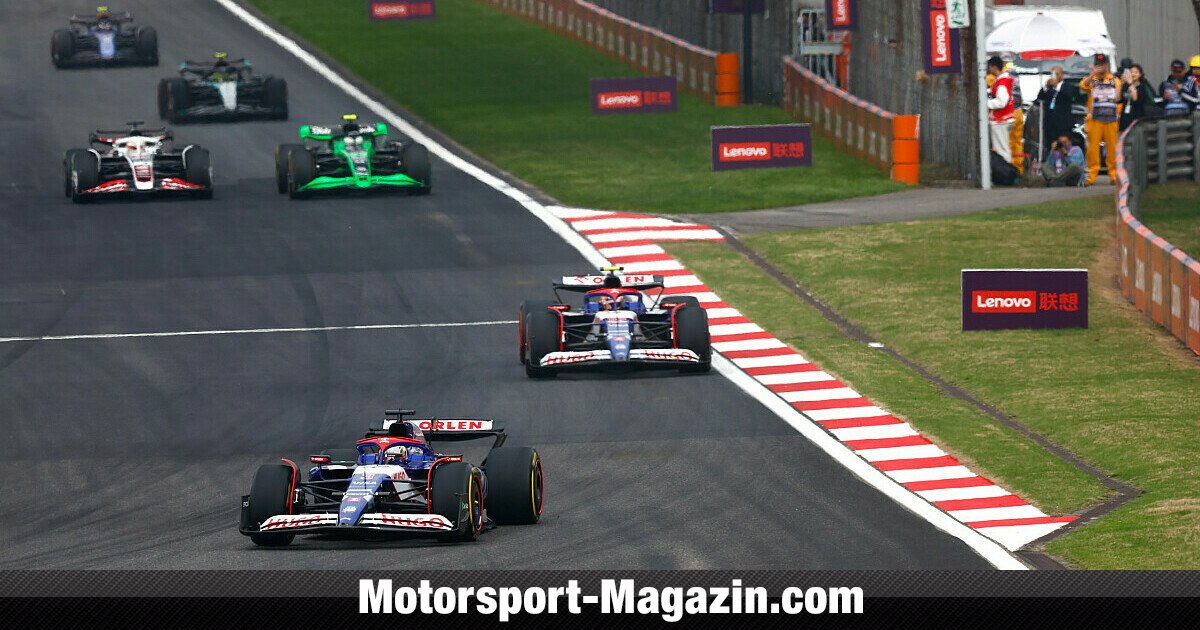In the two-class society of Formula 1 2024, the fight for the last remaining points behind the five regular top teams is just as hard, if not harder. After nine races, the picture is clear enough to take stock of the five-way battle between Racing Bulls, Haas, Alpine, Williams and Sauber. Motorsport-Magazin.com analyzes the balance of power.
6th in the World Championship / 1st in the backfield: Racing Bulls in uninterrupted F1 upswing
The rear of the field has an increasingly serious problem, and that is the Racing Bulls. After rebranding in Bahrain, they actually started in this tight five-team block, but since the season has picked up speed, the small Red Bull team has pulled away. Five of nine races resulted in points, 28 of them. Thanks to consistency, the lead over the pursuers is already large, 21 over Haas. And actually only 30 behind Aston Martin.
Of all the teams in the chasing field, the Racing Bulls have implemented the largest update program. Two revisions to the underbody, sidepods, rear wing, and already three different aero levels for different types of track. The direct competition doesn’t seem to be able to keep up. From Australia onwards, apart from one double DNF, a Racing Bull has always been number one in the chasing field, and in qualifying since Imola, and has regularly been able to annoy Aston Martin.
The car seems to be an all-rounder in its frame. There is a growing feeling that the direct competition is no longer keeping up. If Daniel Ricciardo can more consistently use the potential he showed in Miami and Canada with his efforts to take a new approach in Monaco, then he and Yuki Tsunoda, who is reliable in almost every race, will make it difficult to catch up with the Racing Bulls again.
7th in the World Championship / 2nd in the back field: Will Haas be fully developed again in 2024?
Unlike in recent years, the team is running an update program, but not a gigantic one. The underbody, diffuser, small improvements to the fairing and front wing are not enough to keep up with the Racing Bulls. They are more like just doing the bare minimum. So it is not surprising that Hülkenberg ended up in eleventh place in three of the last four races. Good, but not good enough.
With increased team efficiency, however, Haas could possibly close the gap again without spending resources. Good strategies in Australia and Japan are contrasted with dubious ones in Imola or Canada. In Monaco, the mechanics screwed the high-downforce package together incorrectly and caused a disqualification. And Kevin Magnussen has already received ten penalty points. Komatsu’s newly installed, feedback-heavy open communication, which he wants to install, will be necessary to consolidate the position.
8th in the World Championship / 3rd in the back field: Alpine pulls itself halfway out of the Formula 1 swamp
When it comes to performance, Alpine is in a difficult situation too. After two mediocre ground-effect years, they tried a redesign and failed miserably. In their Bahrain iteration, the car was overweight and poorly balanced. This shifted development priorities. First get rid of the weight, then produce new parts. They stuck with two smaller performance packages and a lighter chassis.
At least – the lighter car has achieved better results in recent races. In Monaco, Gasly managed a Q3 appearance. The points for both drivers in Canada were more a result of a good rain strategy. But they underlined that the A524 has now definitely found its place in the field and is no longer lagging behind. Nevertheless, in terms of current performance, the car is probably still behind Haas.
9th in the World Cup / 4th in midfield: Slim-down Williams finally gets into shape thanks to Albon
As with Alpine, purely performance-oriented updates are few and far between. At Williams, they are actually non-existent, apart from track-specific (and therefore essential) parts. The priority is to slim down. Underbody update? Just lighter. Suspension update? Just lighter. Without performance updates and with a lost For Logan Sargeant in the second cockpit it is a continuing misery.
Albon had been in 14th place for four races. In Monaco and Canada, the cost-cutting seemed to have its first positive effects. However, more than just weight reduction is needed, especially for better, consistent race pace. The Williams still seems to be sitting at about Alpine level. It’s a race of the overweight to see who can get the performance development on track faster.
10th in the World Cup / Now the only backbencher? There is a crisis at Sauber
Sauber went into the new season with cautious optimism, new chassis, new suspension, good feeling during the test. The first worrying problem was the pit stops. They had also wanted to improve these in the winter, but equipment problems resulted in repeated long downtimes, and the first makeshift solution was not effective either. Only new equipment from Imola onwards seemed to solve the problem.
Out on the track, the first steps were small. Front wing in Australia, underbody in Japan, then Valtteri Bottas in China in Q3. But since Miami, doubts have been growing. Further underbody adjustments in Imola brought no performance improvements. The high downforce package for Monaco was a disaster, the car half a second behind the rest of F1.
While the competition is improving its cars, Sauber is slipping further and further in the last few races. Valtteri Bottas reports a driveable car that is just too slow. At the moment it seems clear that it is slow and aerodynamically inefficient. Zhou Guanyu made it even worse with two miserable races. At the moment the C44 is definitely the tenth best car. A difficult situation for a team that wants to be the Audi factory team in a year and a half.
